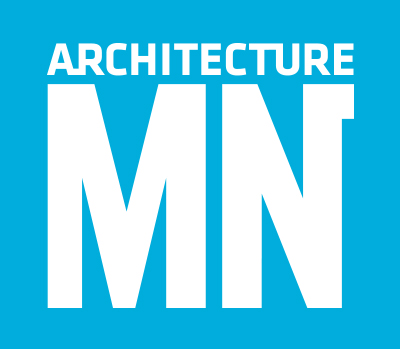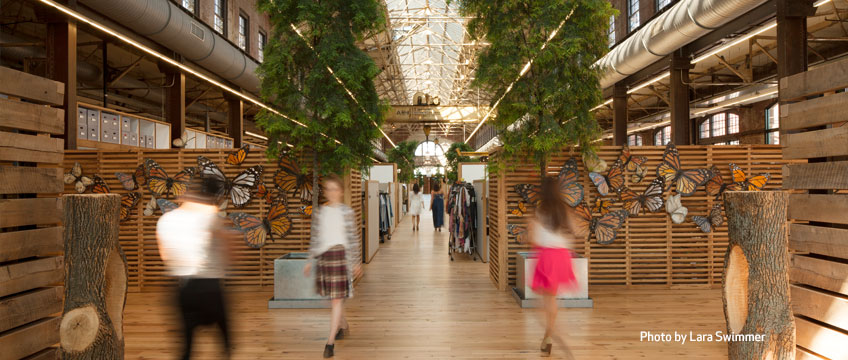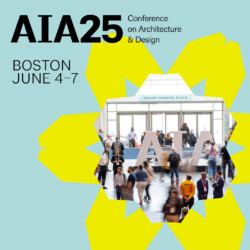MSR brings harmony to a tangle of Philadelphia Navy Yard buildings for Urban Outfitters’ Anthropologie brand. It’s the culmination of a stunningly distinctive corporate campus—and a new standard for adaptive reuse across the country.
By John Reinan
Ten years and 10 buildings into a long-term engagement at the Navy Yard in Philadelphia, Minneapolis-based MSR has developed a sure hand at tackling the challenges of large-scale adaptive reuse. But its most recent project posed a set of problems the firm hadn’t yet encountered.
The centerpiece of its latest Navy Yard redevelopment for Philadelphia-based Urban Outfitters was a massive, cross-shaped, 1904 masonry building in the Renaissance Revival style. Originally housing a metal foundry, Building 18 is one of the oldest remaining structures on the sprawling site, once the nation’s largest shipbuilding facility. Its new tenant would be Anthropologie, an upscale clothing, furniture, and housewares unit of Urban Outfitters.
Over the years, as the Navy Yard needed additional capacity, a series of additions grew like vines over and around the stout walls of Building 18. Ranging from a 1940s stucco annex with ribbon windows to a giant corrugated-metal shed, the additions presented a hodgepodge of structural and architectural puzzles the MSR team would have to solve.
“This was the most complicated building we’ve done,” says MSR principal Josh Stowers, AIA. “It was intertwined with later, neighboring buildings, both structurally and aesthetically. We had to uncouple them.”
MSR’s approach to the project was guided by a fundamental principle that it’s followed throughout its work at the Navy Yard: rehabilitation, not preservation. So what does that look like in practice? An example: The large vehicular openings at the end of the building were infilled with modern steel and glass assemblies. The dramatic apertures remain, but they function as a modern feature.
“We don’t replicate old just for the sake of replicating old,” says Stowers. Yet the old is embraced with enthusiasm. A majestic terra-cotta eagle perched atop the building’s entrance, for example, had somehow lost a wing over the years. The eagle remains—still sans one wing.
The interior of the building is massive—nearly 100,000 square feet on one level, with a main run the length of two football fields. “It’s just an immense distance,” says Stowers. “If you’re in the south end and you have a meeting in the north end, you better plan for some walking time in your calendar.
“It’s really impressive when you first see it, but to live in it day after day . . . there needs to be some manageable human spaces,” he continues. “So we had to break up the scale.”
One ingenious scale-breaker made use of the giant rail cranes that once moved pieces of ships weighing hundreds of tons. The MSR team suspended the building’s mechanical rooms from one of the cranes. Suspended from another crane is a chandelier.
The main spaces are also filled with meeting rooms and design areas, each delineated with wooden dividers that also serve as a custom hanging system for clothing and houseware samples. Over it all is a network of skylights running nearly the entire length of the two bars of the original building. Natural light was a key consideration in all design decisions, says MSR senior associate Dan Vercruysse, AIA.
“The designers create furniture, clothing, housewares. They love daylight as much as anyone can love daylight,” he says. “So to sit and work under the skylight is just incredible. We wanted to give everybody access to daylight. If it’s not from above, then it’s from the sides.”
Adaptive reuse is built into the DNA of Urban Outfitters, says Dave Ziel, the company’s chief development officer. Most of its retail stores, like its Navy Yard corporate spaces, are repurposed rather than built new. “It’s important to our company,” he says. “Adaptive reuse fuels our design and approach. You get a unique creativity. And the creative class, which is our employee and customer, really responds positively to the spaces we’re designing.”
The experience of Building 18 is a series of “unique moments,” he says. “The ornateness of the masonry is so amazing. I don’t think you could even find masons today who could construct those buildings. The structural steel components—specifically the trusses—are beautiful. You just don’t see the mass, the span, the webbing, and the riveting anymore.”
The Anthropologie headquarters benefited from the decade-long collaboration between client and architect, says Vercruysse. “In large part, it’s been the same team from the beginning. And building off those relationships [the process and the results have] gotten better and better,” he says.
What has changed over the past 10 years—and changed dramatically—is the technology environment for architect and client. “We started the first building in CAD,” says Stowers. “Now we’re using Revit and 3D. In the old days—2005—we would bring printouts to meetings with the client. Now we bring a laptop, and the client sits with us and reviews the options in real time.”
Will Urban Outfitters ever lose its appetite for converting old buildings to new uses, keeping the best of what’s there? Not likely, says Ziel. “[Our approach] creates a very unique working atmosphere that’s still true to the building’s roots,” he says. “My favorite term for it is ‘deconstructive reconstruction.’ If the building lends itself to adaptive reuse, we’re absolutely going to do it every time.”
ANTHROPOLOGIE (BUILDING 18)
Location: Philadelphia, Pennsylvania
Client: Urban Outfitters, Inc.
Architect: MSR (Meyer, Scherer & Rockcastle, Ltd.)
msrdesign.com
Principal-in-charge: Josh Stowers, AIA
Project lead designer: Dan Vercruysse, AIA
Landscape architect: D.I.R.T. Studio
www.dirtstudio.com
General contractor: Blue Rock Construction
Size: 110,360 square feet
Completion: June 2014
Photographer: Lara Swimmer



